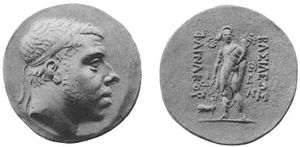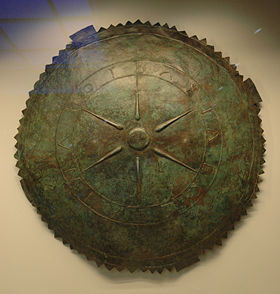
Pharnaces I of Pontus
Encyclopedia

Pontus
Pontus or Pontos is a historical Greek designation for a region on the southern coast of the Black Sea, located in modern-day northeastern Turkey. The name was applied to the coastal region in antiquity by the Greeks who colonized the area, and derived from the Greek name of the Black Sea: Πόντος...
and was of Persian
Persian people
The Persian people are part of the Iranian peoples who speak the modern Persian language and closely akin Iranian dialects and languages. The origin of the ethnic Iranian/Persian peoples are traced to the Ancient Iranian peoples, who were part of the ancient Indo-Iranians and themselves part of...
and Greek Macedonian
Ancient Macedonians
The Macedonians originated from inhabitants of the northeastern part of the Greek peninsula, in the alluvial plain around the rivers Haliacmon and lower Axios...
ancestry. He was the son of King Mithridates III of Pontus
Mithridates III of Pontus
Mithridates III was the fourth King of Pontus, son of Mithridates II of Pontus and Laodice. Mithridates had two sisters who were Laodice III the first wife of the Seleucid King Antiochus III the Great and Laodice of Pontus. He may have ruled in an uncertain period between 220 BC and 183 BC...
and his wife Laodice
Laodice (wife of Mithridates III of Pontus)
Laodice was a Greek Princess from the Seleucid Empire and the wife of the King Mithridates III of Pontus....
, whom he succeeded on the throne. Pharnaces had two siblings: a brother called Mithridates IV of Pontus
Mithridates IV of Pontus
Mithridates IV of Pontus or known by his full name Mithridates Philopator Philadelphus was a prince and sixth King of the Kingdom of Pontus....
and a sister called Laodice
Laodice (sister-wife of Mithridates IV of Pontus)
-Family and Ancestry:Laodice was of Greek Macedonian and Persian ancestry. She was the daughter of the Monarchs Laodice and Mithridates III of Pontus. Her brothers were Mithridates IV of Pontus and Pharnaces I of Pontus who served as Kings of Pontus after the death of their parents...
who succeeded as Pontian monarchs on the throne. He was born and raised in the Kingdom of Pontus.
The date of his accession cannot be fixed with certainty; but it is certain, at least, that he was on the throne before 183 BC
183 BC
Year 183 BC was a year of the pre-Julian Roman calendar. At the time it was known as the Year of the Consulship of Marcellus and Labeo...
, in which year he succeeded in reducing the important city of Sinope
Sinop, Turkey
Sinop is a city with a population of 36,734 on İnce Burun , by its Cape Sinop which is situated on the most northern edge of the Turkish side of Black Sea coast, in the ancient region of Paphlagonia, in modern-day northern Turkey, historically known as Sinope...
, which had been long an object of ambition to the Kings of Pontus. The Rhodians
Rhodes
Rhodes is an island in Greece, located in the eastern Aegean Sea. It is the largest of the Dodecanese islands in terms of both land area and population, with a population of 117,007, and also the island group's historical capital. Administratively the island forms a separate municipality within...
sent an embassy to Rome
Rome
Rome is the capital of Italy and the country's largest and most populated city and comune, with over 2.7 million residents in . The city is located in the central-western portion of the Italian Peninsula, on the Tiber River within the Lazio region of Italy.Rome's history spans two and a half...
to complain of this aggression, but without effect. About the same time Pharnaces became involved in disputes with his neighbour, King of Pergamon
Pergamon
Pergamon , or Pergamum, was an ancient Greek city in modern-day Turkey, in Mysia, today located from the Aegean Sea on a promontory on the north side of the river Caicus , that became the capital of the Kingdom of Pergamon during the Hellenistic period, under the Attalid dynasty, 281–133 BC...
, Eumenes II
Eumenes II
Eumenes II of Pergamon was king of Pergamon and a member of the Attalid dynasty. The son of king Attalus I and queen Apollonis, he followed in his father's footsteps and collaborated with the Romans to oppose first Macedonian, then Seleucid expansion towards the Aegean, leading to the defeat of...
, which led to repeated embassies from both monarchs to Rome, as well as to partial hostilities. But in the spring of 181 BC
181 BC
Year 181 BC was a year of the pre-Julian Roman calendar. At the time it was known as the Year of the Consulship of Cethegus and Tamphilus...
, without waiting for the return of his ambassadors, Pharnaces suddenly attacked both Eumenes II and King Ariarathes IV of Cappadocia
Ariarathes IV of Cappadocia
Ariarathes IV Eusebes , son of the king of Cappadocia Ariarathes III and Stratonice. He was a child at his accession, and reigned 220—163 BC, about 57 years. He married Antiochis, the daughter of Antiochus III the Great, king of Syria, and wife Laodice III, and, in consequence of this alliance,...
and invaded Galatia
Galatia
Ancient Galatia was an area in the highlands of central Anatolia in modern Turkey. Galatia was named for the immigrant Gauls from Thrace , who settled here and became its ruling caste in the 3rd century BC, following the Gallic invasion of the Balkans in 279 BC. It has been called the "Gallia" of...
with a large force.

Roman Republic
The Roman Republic was the period of the ancient Roman civilization where the government operated as a republic. It began with the overthrow of the Roman monarchy, traditionally dated around 508 BC, and its replacement by a government headed by two consuls, elected annually by the citizens and...
deputies, appointed by the Roman Senate
Roman Senate
The Senate of the Roman Republic was a political institution in the ancient Roman Republic, however, it was not an elected body, but one whose members were appointed by the consuls, and later by the censors. After a magistrate served his term in office, it usually was followed with automatic...
to inquire into the matters in dispute. Negotiations were accordingly opened at Pergamon but led to no result, the demands of Pharnaces being rejected by the Romans as unreasonable; and the war was in consequence renewed. It continued, apparently with various interruptions, until the summer of 179 BC
179 BC
Year 179 BC was a year of the pre-Julian Roman calendar. At the time it was known as the Year of the Consulship of Flaccus and Fulvianus...
, when Pharnaces, finding himself unable to cope with the combined forces of Eumenes II and Ariarathes IV, was compelled to purchase peace by the cession of all his conquests in Galatia and Paphlagonia
Paphlagonia
Paphlagonia was an ancient area on the Black Sea coast of north central Anatolia, situated between Bithynia to the west and Pontus to the east, and separated from Phrygia by a prolongation to the east of the Bithynian Olympus...
, with the exception of Sinope. How long he continued to reign after this we know not; but it appears, from an incidental notice, that he was still on the throne in 170 BC
170 BC
Year 170 BC was a year of the pre-Julian Roman calendar. At the time it was known as the Year of the Consulship of Mancinus and Serranus...
, while he was certainly dead in 154 BC
154 BC
Year 154 BC was a year of the pre-Julian Roman calendar. At the time it was known as the Year of the Consulship of Opimius and Albinus/Glabrio...
, when his brother Mithridates IV of Pontus
Mithridates IV of Pontus
Mithridates IV of Pontus or known by his full name Mithridates Philopator Philadelphus was a prince and sixth King of the Kingdom of Pontus....
is mentioned as King. The Greek historian Polybius
Polybius
Polybius , Greek ) was a Greek historian of the Hellenistic Period noted for his work, The Histories, which covered the period of 220–146 BC in detail. The work describes in part the rise of the Roman Republic and its gradual domination over Greece...
accuses Pharnaces of having an arrogant and violent character, siding with the opinion of Eumenes II and the Romans.
Pharnaces married a Greek Seleucid Princess
Seleucid Empire
The Seleucid Empire was a Greek-Macedonian state that was created out of the eastern conquests of Alexander the Great. At the height of its power, it included central Anatolia, the Levant, Mesopotamia, Persia, today's Turkmenistan, Pamir and parts of Pakistan.The Seleucid Empire was a major centre...
called Nysa, who was the child of princess Laodice IV
Laodice IV
Laodice IV was a Greek Princess, Head Priestess and Queen of the Seleucid Empire.-Ancestry, Family & Early Life:...
and crown prince Antiochus
Antiochus (son of Antiochus III the Great)
Antiochus was a Greek Seleucid Prince, first born child to the Seleucid Monarchs Antiochus III the Great and Laodice III and his father’s first heir....
. Nysa and Pharnaces were related as the parents of Nysa were first cousins with Pharnaces. Pharnaces married Nysa either in 172 BC or 171 BC, through the diplomatic work of the Seleucid King Demetrius I Soter
Demetrius I Soter
Demetrius I , surnamed Soter , was a ruler of the Hellenistic Seleucid Empire....
.
Honorific statues and inscriptions have survived that were dedicated to Pharnaces and Nysa. Pharnaces set about to establish good relations with the citizens of Athens
Athens
Athens , is the capital and largest city of Greece. Athens dominates the Attica region and is one of the world's oldest cities, as its recorded history spans around 3,400 years. Classical Athens was a powerful city-state...
and the Greek island of Delos
Delos
The island of Delos , isolated in the centre of the roughly circular ring of islands called the Cyclades, near Mykonos, is one of the most important mythological, historical and archaeological sites in Greece...
. Pharnaces made a benefaction to the people of Athens. The exact nature of the benefaction is unknown, perhaps Pharnaces may have made some kind of voluntary donation to Athens, perhaps soon after 183 BC. A lengthy honorific inscription from the Athenians on Delos honors Pharnaces and Nysa. Pharnaces and Nysa received a crown of gold from them and bronze statues of themselves were set up on Delos. Their lengthy Athenian honorific inscription, is dated in the Archonship of the Athenian Tychandrus or Tychander which is now generally accepted as 160 BC or 159 BC.
Nysa bore Pharnaces two children: a son called Mithridates V of Pontus
Mithridates V of Pontus
Mithridates V Euergetes ; also known as Mithridates V of Pontus, Mithradates V of Pontus and Mithradates V Euergetes, was a Prince and seventh King of the wealthy Kingdom of Pontus.Mithridates V was of Greek Macedonian and Persian ancestry...
and a daughter called Nysa of Cappadocia, who is also known as Laodice
Laodice
-Greek mythology:* Laodice , daughter of Priam, king of Troy* Laodice, daughter of Agamemnon, a.k.a. Electra* Laodice, one of the Hyperborean maidens* Laodice, consort of Phoroneus...
. Nysa died at an unknown date in the 2nd century BC, she is believed to have died during childbirth, when she was giving birth to one of her children.
Sources
- B.C. McGing, The foreign policy of Mithridates VI Eupator, King of Pontus, BRILL, 1986
- J.D. Grainger, A Seleukid prosopography and gazetteer, BRILL, 1997
- http://www.livius.org/la-ld/laodice/laodice_iv.html
- Greek Wikipedia article of Nyssa of Pontus

